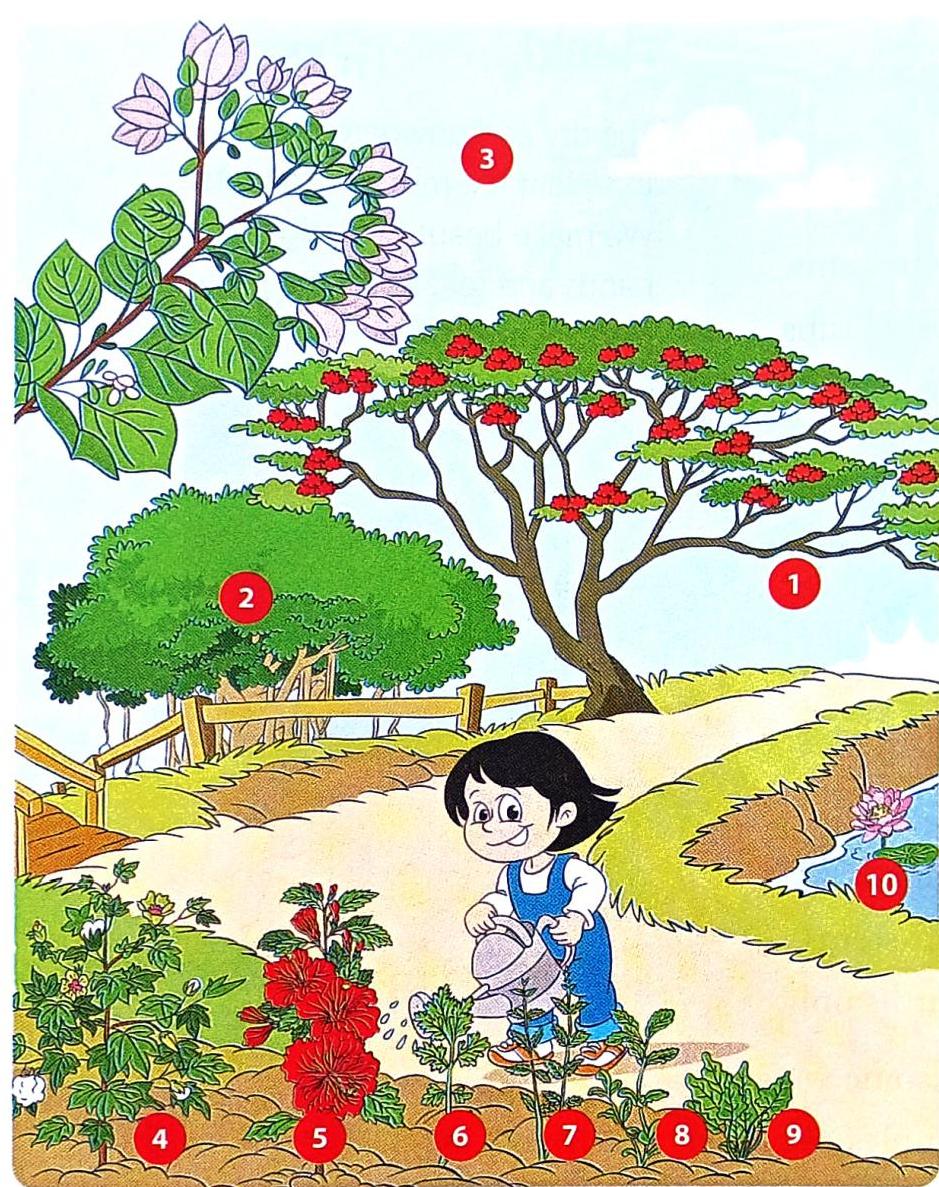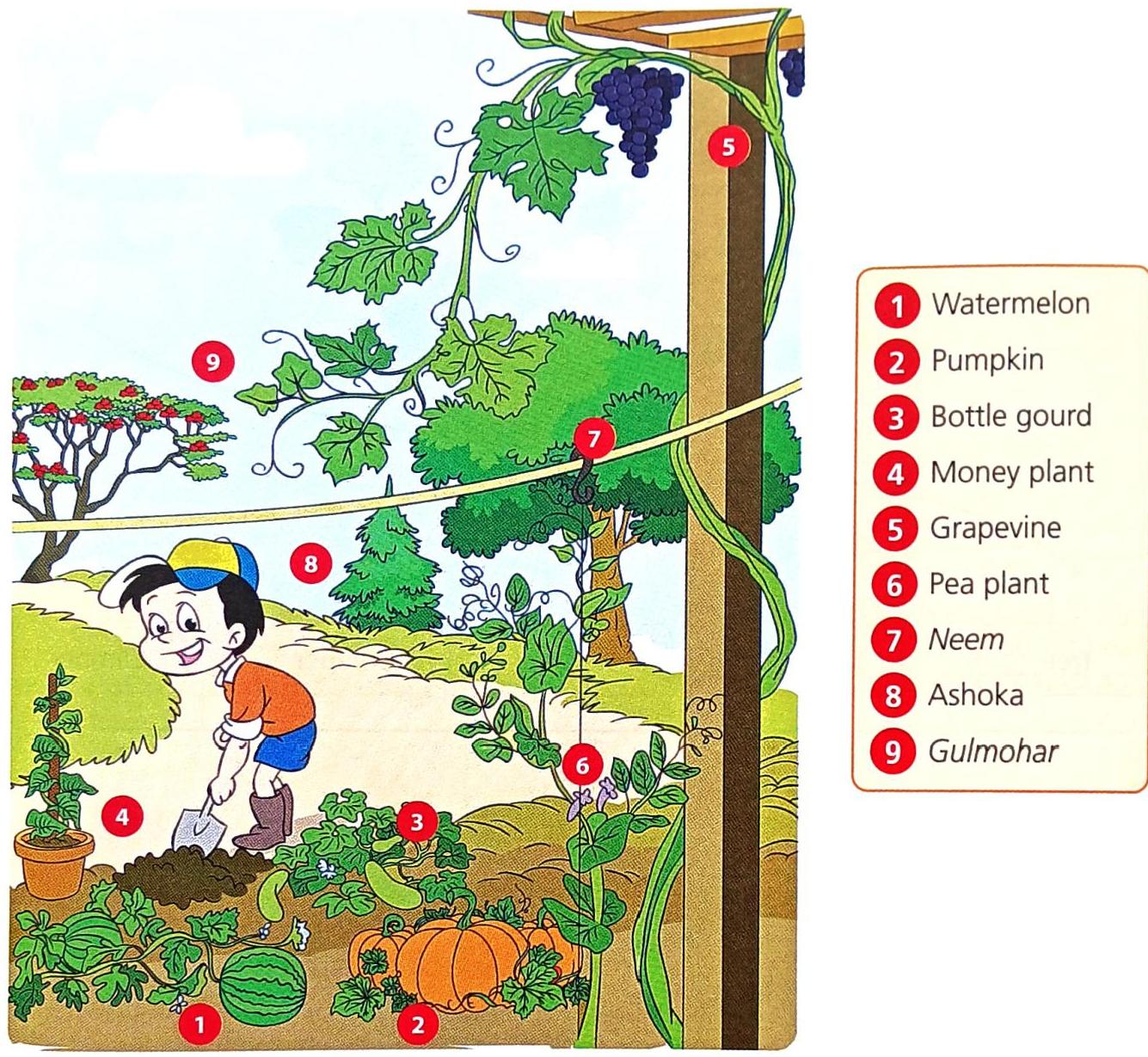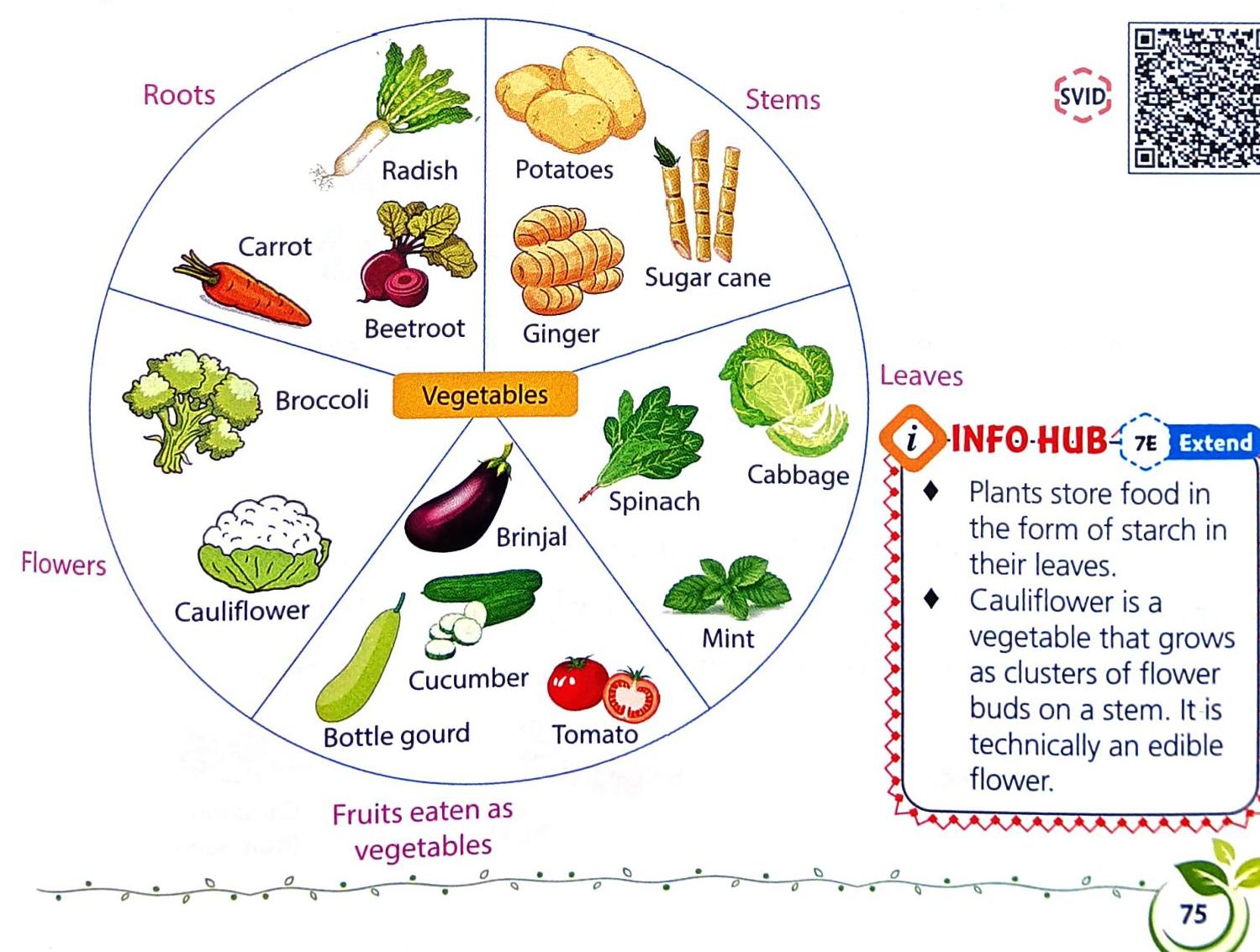Chapter: 06. Food We Get From Plants
Food We Get from Plants
Plants are amazing living things all around us! They come in many different shapes and sizes, and they help us in so many ways. Some plants are huge, and some are tiny. Some live only for a few months, while others can live for many, many years!
Types of Plants
There are many kinds of plants, and each one has special features that help us tell them apart. Let’s explore the main types!
Did You Know? Plants have different lifespans. Some plants, like trees, can live for many years, while others, like some herbs, might only live for a few months.
Here’s a look at some plants in a garden:
Trees
Trees are the biggest and tallest plants you’ll see.
Stems: They have a main stem that is brown, hard, very thick, and woody. This strong main stem is called a trunk. Bark: The trunk is covered and protected by a hard outer layer called the bark. Branches: Trees have many branches growing from their trunk. These branches hold leaves, beautiful flowers, and yummy fruits. Roots: Their roots are very strong and thick, growing deep down into the soil to hold the tree firmly. Lifespan: Trees usually live for many, many years. Examples: Gulmohar, Ashoka, Banyan, Neem, and Apple trees are all examples of trees. Shrubs
Shrubs are smaller than trees but still have woody stems.
Size & Growth: They are smaller than trees and often grow close to the ground, appearing bushy. Stems: Their stems are thin, brown, and hard, but not as thick as a tree trunk. Lifespan: Most shrubs live for a few years. Examples: Cotton plant, Rose plant, Mehndi (Henna), Bougainvillea, and Hibiscus are common examples of shrubs. Herbs
Herbs are the smallest and softest types of plants.
Size & Stems: They are small plants with thin, green, and soft stems. Lifespan: Most herbs live for only a few months. Examples: Mint, Coriander, Spinach, and some water plants like Lotus are examples of herbs. Interesting Fact: The dry and powdered leaves of the Mehndi plant (a shrub) are mixed with water to make a paste. This paste is used to create beautiful designs on hands and feet!
Queen of Herbs: Tulsi is a very special herb often called the “queen of herbs.” It’s also widely used in medicines!
Creepers
Creepers are plants that like to spread out.
Stems: They have weak stems. Growth: Instead of growing tall, they creep or spread along the ground. Fruits: They often produce big, heavy fruits. Examples: Watermelon, Pumpkin, and Bottle gourd are examples of creepers. Climbers
Climbers are plants that need a little help to grow tall.
Stems: They have weak stems and cannot stand straight on their own. Support: They need the support of walls, sticks, or other plants to climb and grow upwards. Examples: Money plant, Grapevine, and Pea plant are examples of climbers. Here’s Hari’s garden, showing some trees, climbers, and creepers:
Uses of Plants
Plants are incredibly useful and important to us. They are truly our “green friends.”
Many Products: We get so many essential things from plants, including food, medicines, wood, rubber, gum, oils, paper, and perfumes. Environment: They help keep our surroundings beautiful and make the air fresh and clean for us to breathe. Save Trees! Paper comes from trees. Wasting paper means more trees have to be cut down. Always try to save paper by using both sides, going digital, and recycling! Food from Plants
We eat different parts of various plants as food.
Fruits
We enjoy eating the fruits that grow on some plants.
Examples: Oranges, Apples, Coconuts, and Cherries are some examples of fruits. Vegetables
We eat various parts of plants as vegetables.
Roots: We eat the roots of plants like radish, carrot, and beetroot. Stems: We eat the stems of plants like potatoes, ginger, and sugar cane. Leaves: We eat the leaves of plants such as spinach, cabbage, and mint. Flowers: Some plant flowers, like broccoli and cauliflower, are eaten as vegetables. Fruits eaten as vegetables: Some fruits are commonly eaten as vegetables, such as brinjal (eggplant), cucumber, bottle gourd, and tomato. Products: The fruits and flowers of some plants are also used to make delicious juices, jams, sauces, and pickles. Nuts
Nuts are another type of food we get from plants.
What they are: Nuts are actually the edible seeds of some plants. Examples: Walnuts, Cashew nuts, Almonds, Peanuts, and Pistachios are all popular nuts. Food Grains
Food grains are a very important part of our diet.
What they are: They are the edible seeds of certain plants. Types: Food grains are divided into two main categories: Cereals: These include seeds of plants like wheat, rice, and corn. Pulses: These include seeds of plants like pea and kidney beans. Importance: Cereals and pulses make up a major part of the food we eat every day.
Spices
Spices are what make our food exciting and flavorful!
Purpose: We add spices when we cook food to make it tastier, give it color, and a wonderful aroma. Origin: Spices come from plants. They are typically dried parts of plants, such as: Seeds: Like coriander seeds. Leaves: Like bay leaves (not pictured but an example). Roots: Like ginger (often used as a spice, though also a stem). Examples: Clove (flower bud), Cinnamon (bark), Cardamom (fruit/seeds), Coriander (leaf/seeds), Turmeric (stem/rhizome), Ginger (stem/rhizome), and Chilli (fruit) are common spices.
INFO-HUB In earlier times, people used to cook food in ceramic or clay pots. Cooking food in clay pots is
very healthy. Oil
Oil is obtained from certain plants.
Source: We get oil by crushing the seeds of plants that are rich in oil. Cooking: We use oil for cooking many dishes. Personal Care: We apply oil on our hair and body. Products: Oil is also used to make everyday products like soaps, shampoos, and toothpastes. Examples: Groundnut oil, Coconut oil, Sunflower oil, and Mustard oil are examples of oils we get from plants.
Tea, Coffee, and Sugar
These popular items also come from plants.
Tea: Made from the leaves of the tea plant. Coffee: Made from the seeds of the coffee plant. Sugar: We get sugar from the stems of sugar cane plants. Sugar is used in making sweets, shakes, and ice creams. Cocoa: Cocoa is obtained from the seeds of the cacao tree. It is famously used to make chocolate!
Medicines from Plants
Some plants are known for their healing properties and are used to make medicines. These are called medicinal plants.
Tulsi leaves: Used to help cure cough and cold. Cloves: Used to treat toothache. Neem: An excellent cure for skin infections because it helps kill germs. It’s also used in toothpastes and soaps. Fennel seeds: Good for the digestive system. Amla (Indian Gooseberry): Rich in Vitamin C and used for boosting immunity and aiding digestion. Aloe vera: Used for healing skin burns and irritation, and for digestive health. Haldi (Turmeric): Known for its antiseptic and anti-inflammatory properties; used to heal wounds and reduce swelling. Eucalyptus: Its oil is used in vapor rubs and inhalers to clear congestion and relieve coughs. Chapter Summary
Here’s a quick recap of everything we’ve learned about plants!
 Self Study
Self Study























